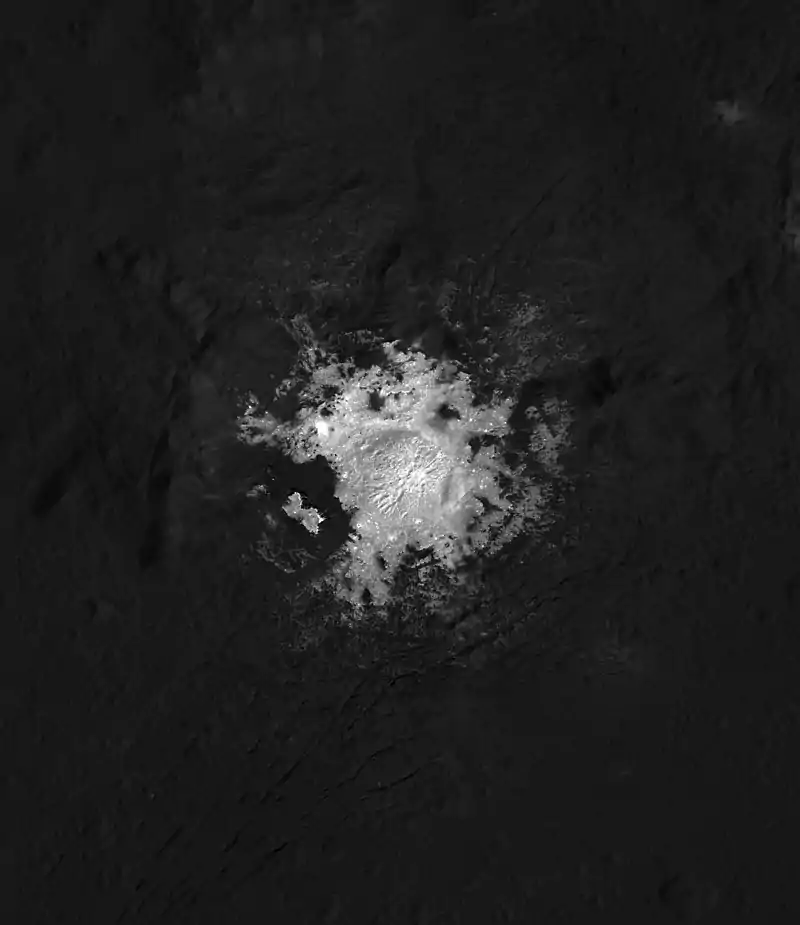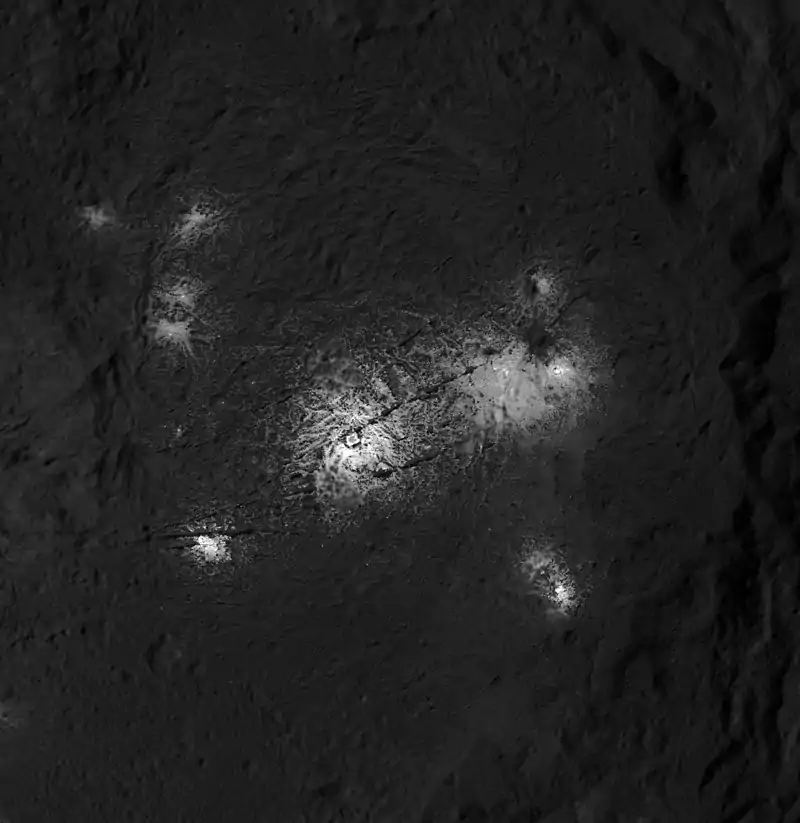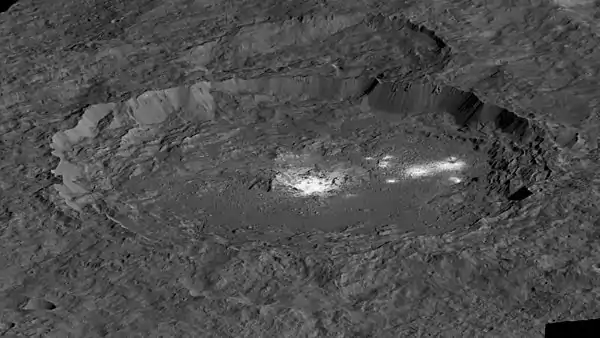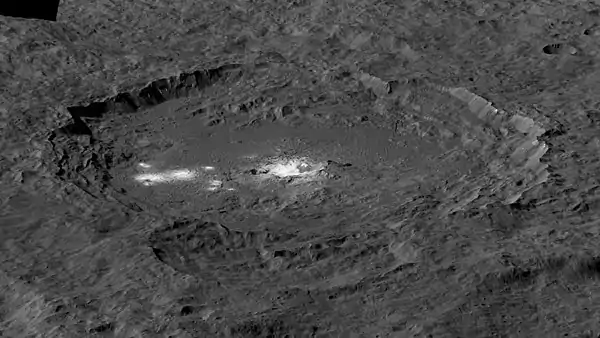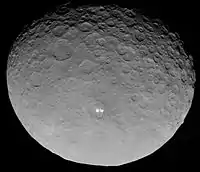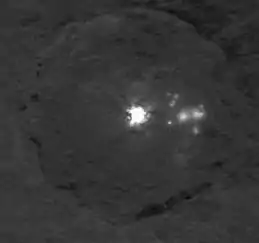Occator (crater)
Occator /ɒˈkeɪtər/ is an impact crater located on Ceres, the largest object in the main asteroid belt that lies between the orbits of Mars and Jupiter, that contains "Spot 5", the brightest of the bright spots observed by the Dawn spacecraft. It was known as "Region A" in ground-based images taken by the W. M. Keck Observatory on Mauna Kea.[2]
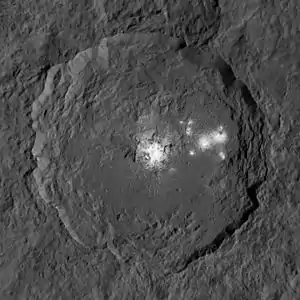 Occator imaged by Dawn from LAMO. Fractures are associated with the bright spots and some other areas. | |
| Location | Ceres |
|---|---|
| Coordinates | 19.86°N 238.85°E[1] |
| Diameter | 92 kilometres (57 mi) |
| Depth | 4 km |
| Naming | After Occātor, a helper God of Ceres |
The crater was named after Occator, the Roman god of the harrow and a helper to Ceres. The name Occator was officially approved by the IAU on 3 July 2015.[1]
On 9 December 2015, scientists reported that the bright spots on Ceres, including those in Occator, may be related to a type of salt, particularly a form of brine containing magnesium sulfate hexahydrite (MgSO4·6H2O); the spots were also found to be associated with ammonia-rich clays.[3] More recently, on 29 June 2016, scientists reported the bright spot to be mostly sodium carbonate (Na
2CO
3), implying that hydrothermal activity was probably involved in creating the bright spots.[4][5] In August 2020, NASA confirmed that Ceres was a water-rich body with a deep reservoir of brine that percolated to the surface in various locations causing the "bright spots", including those in Occator crater.[6][7]
A small dome in the center of the crater is 3 km across and about 340 meters height. It is named Cerealia Tholus[8] and is covered by bright salt deposits named Cerealia Facula.[9] The group of thinner salt deposits to the east are named Vinalia Faculae [sic].[10] In July 2018, NASA released a comparison of physical features, including Occator, found on Ceres with similar ones present on Earth.[11]
Views

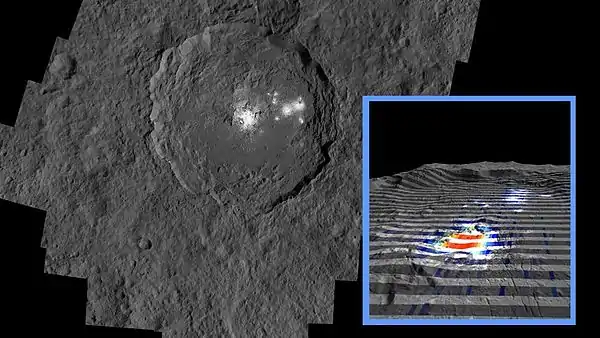
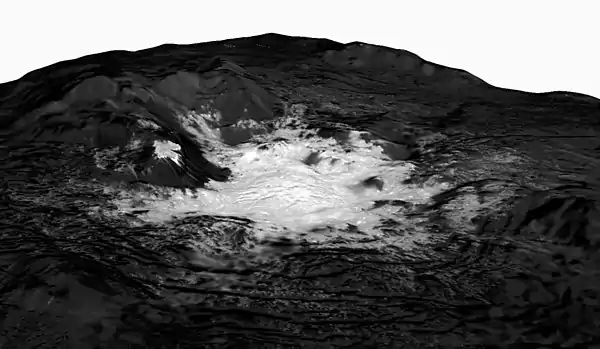
(22 km (14 mi)) (August 2018)

 View rendered from
View rendered from
topographic data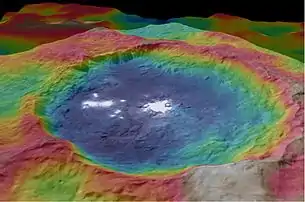 Topographic map
Topographic map
(October 2015)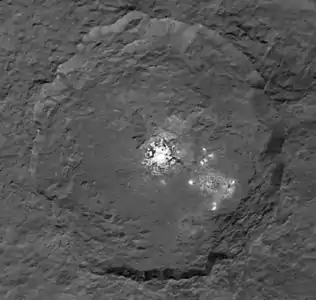 Occator from HAMO. Composite image, so bright spot is not overexposed.
Occator from HAMO. Composite image, so bright spot is not overexposed.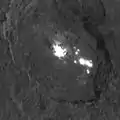 Oblique view
Oblique view
(October 2015)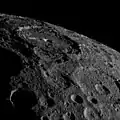 Lateral view
Lateral view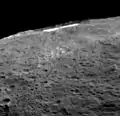 Lateral view
Lateral view
(December 2015) False colors
False colors
(December 2015) 3D-like perspective
3D-like perspective
(December 2015)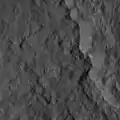 Western rim
Western rim
(January 2016)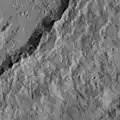 Southeastern rim
Southeastern rim
(January 2016)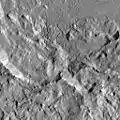 Fractures inside crater
Fractures inside crater
(August 2016)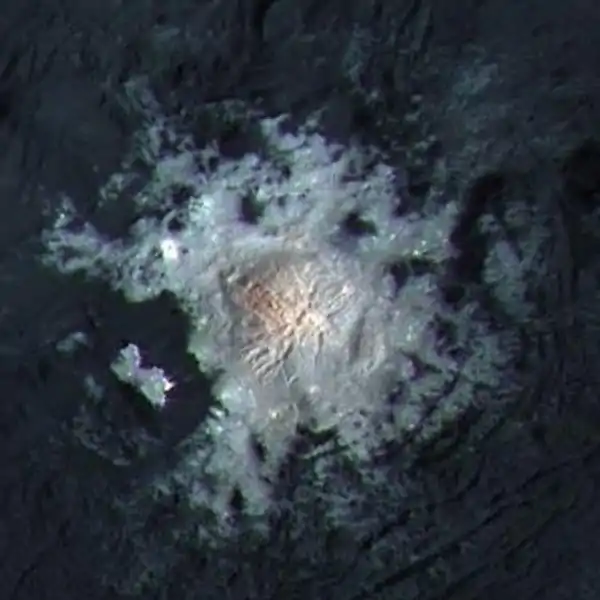 LAMO close-up
LAMO close-up
CerealiaFacula
(February 2016)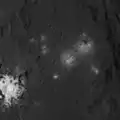 Context of preceding image
Context of preceding image
(LAMO; March 2016)
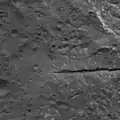 Final orbit-FloorFractures
Final orbit-FloorFractures
(116 km (72 mi))
(July 2018)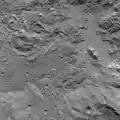 Final orbit-FractureNetwork
Final orbit-FractureNetwork
(107 km (66 mi))
(July 2018)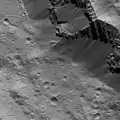 Final orbit-FractureNetwork
Final orbit-FractureNetwork
(76 km (47 mi))
(July 2018)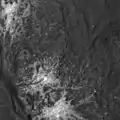 Final orbit-FractureNetwork
Final orbit-FractureNetwork
(46 km (29 mi))
(July 2018)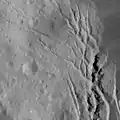 Final orbit-FractureNetwork
Final orbit-FractureNetwork
(36 km (22 mi))
(June 2018)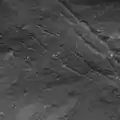 Final orbit-Fractures
Final orbit-Fractures
(35 km (22 mi))
(July 2018)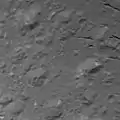 Final orbit-Dome & Fractures
Final orbit-Dome & Fractures
(44 km (27 mi))
(July 2018) Final orbit-Dome
Final orbit-Dome
(51 km (32 mi))
(July 2018)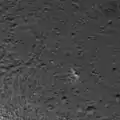 Final orbit-FloorPatterns
Final orbit-FloorPatterns
(52 km (32 mi))
(July 2018)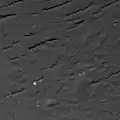 Final orbit-Floor
Final orbit-Floor
(48 km (30 mi))
(July 2018)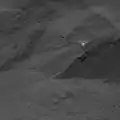 Final orbit-Scarp
Final orbit-Scarp
(42 km (26 mi))
(July 2018)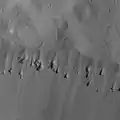 Final orbit-Landslides
Final orbit-Landslides
(44 km (27 mi))
(June 2018)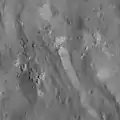 Final orbit-Boulders
Final orbit-Boulders
(43 km (27 mi))
(June 2018)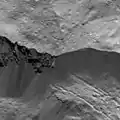 Final orbit-CraterWall
Final orbit-CraterWall
(116 km (72 mi))
(July 2018)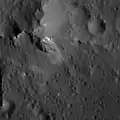 Final orbit-CraterWall
Final orbit-CraterWall
(116 km (72 mi))
(July 2018)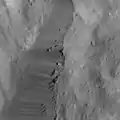 Final orbit-EasternRim-1
Final orbit-EasternRim-1
(44 km (27 mi))
(June 2018)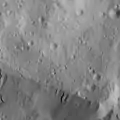 Final orbit-EasternRim-2
Final orbit-EasternRim-2
(44 km (27 mi))
(June 2018)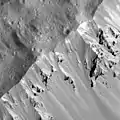 Final orbit-NorthernWall
Final orbit-NorthernWall
(33 km (21 mi))
(June 2018)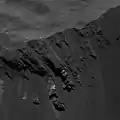 Final orbit-SoutheastWall
Final orbit-SoutheastWall
(39 km (24 mi))
(June 2018)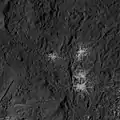 Final orbit-Stars
Final orbit-Stars
(143 km (89 mi))
(July 2018) Final orbit-Stars
Final orbit-Stars
(34 km (21 mi))
(June 2018) Final orbit-BrightMaterial
Final orbit-BrightMaterial
(48 km (30 mi))
(July 2018)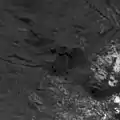 Final orbit-BrightMaterial
Final orbit-BrightMaterial
(55 km (34 mi))
(July 2018)
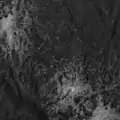 Final orbit-VinaliaFaculae
Final orbit-VinaliaFaculae
(39 km (24 mi))
(June 2018)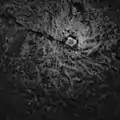 Final orbit-VinaliaFaculae
Final orbit-VinaliaFaculae
(58 km (36 mi))
(July 2018)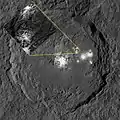 Context of preceding image
Context of preceding image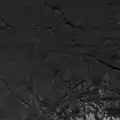 Final orbit-FracturePattern-NearCerealiaFacula
Final orbit-FracturePattern-NearCerealiaFacula
(54 km (34 mi))
(July 2018)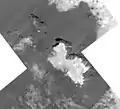 Final orbit-CerealiaFacula-a
Final orbit-CerealiaFacula-a
(34 km (21 mi))
(June 2018)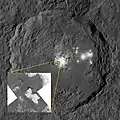 Context of preceding image
Context of preceding image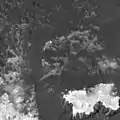 Final orbit-CerealiaFacula-b
Final orbit-CerealiaFacula-b
(34 km (21 mi))
(June 2018) Final orbit-CerealiaFacula-c
Final orbit-CerealiaFacula-c
(34 km (21 mi))
(June 2018) Occator crater
Occator crater
Bright Areas
(10 August 2020) Occator crater
Occator crater
CloseUp
(10 August 2020)
Animations
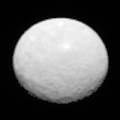 4 February 2015; Dawn
4 February 2015; Dawn
90,000 km (56,000 mi) 29 April 2017: Dawn
29 April 2017: Dawn
20,000 km (12,000 mi)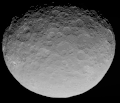 4 May 2015; Dawn
4 May 2015; Dawn
13,600 km (8,500 mi)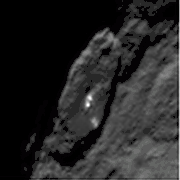
(simulated; 01:15; 8 June 2015)[15]
(false colors; 01:12; 9 December 2015)
(color; 03:43; 29 January 2016)
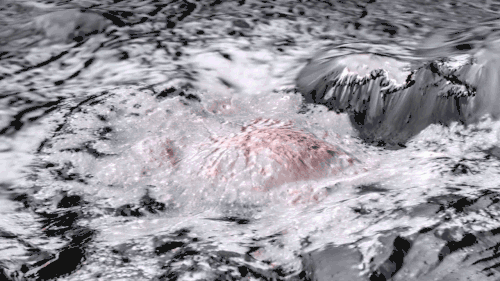
See also
References
- "Occator (crater)". Gazetteer of Planetary Nomenclature. USGS Astrogeology Research Program., accessed 6 July 2015
- Kupper; et al. (22 January 2014). "PIA17831: Water Detection on Ceres". NASA. Retrieved 30 July 2015.
- Landau, Elizabeth (9 December 2015). "New Clues to Ceres' Bright Spots and Origins". NASA. Retrieved 10 December 2015.
- Landau, Elizabeth; Greicius, Tony (29 June 2016). "Recent Hydrothermal Activity May Explain Ceres' Brightest Area". NASA. Retrieved 30 June 2016.
- De Sanctis, M. C.; Raponi, A.; Ammannito, E.; Ciarniello, M.; Toplis, M. J.; McSween, H. Y.; Castillo-Rogez, J. C.; Ehlmann, B. L.; Carrozzo, F. G.; Marchi, S.; Tosi, F.; Zambon, F.; Capaccioni, F.; Capria, M. T.; Fonte, S.; Formisano, M.; Frigeri, A.; Giardino, M.; Longobardo, A.; Magni, G.; Palomba, E.; McFadden, L. A.; Pieters, C. M.; Jaumann, R.; Schenk, P.; Mugnuolo, R.; Raymond, C. A.; Russell, C. T. (29 June 2016). "Bright carbonate deposits as evidence of aqueous alteration on (1) Ceres". Nature. 536 (7614): 54–57. Bibcode:2016Natur.536...54D. doi:10.1038/nature18290. PMID 27362221. S2CID 4465999.
- McCartney, Gretchen; JHautaluoma, Grey; Johnson, Alana (10 August 2020). "Mystery Solved: Bright Areas on Ceres Come From Salty Water Below". NASA. Retrieved 12 August 2020.
- McCartney, Gretchen (11 August 2020). "Mystery solved: Bright areas on Ceres come from salty water below". Phys.org. Retrieved 12 August 2020.
- "Cerealia Facula". Gazetteer of Planetary Nomenclature. USGS Astrogeology Research Program.
- "Vinalia Faculae". Gazetteer of Planetary Nomenclature. USGS Astrogeology Research Program.
- Landau, Elizabeth; McCartney, Gretchen (24 July 2018). "What Looks Like Ceres on Earth?". NASA. Retrieved 25 July 2018.
- Brown, Dwayne; Wendel, JoAnna; McCartney, Gretchen (6 September 2018). "The Legacy of NASA's Dawn, Near End of Mission". NASA. Retrieved 2 November 2018.
- Brown, Dwayne; Wendel, JoAnna; McCartney, Gretchen (1 November 2018). "NASA's Dawn Mission to Asteroid Belt Comes to End". NASA. Retrieved 2 November 2018.
- Chang, Kenneth (1 November 2018). "NASA's Dawn Mission to the Asteroid Belt Says Good Night - Launched in 2007, the spacecraft discovered bright spots on Ceres and forbidding terrain on Vesta". The New York Times. Retrieved 2 November 2018.
- Landau, Elizabeth; Dyches, Preston (8 June 2015). "Fly Over Ceres in New Video". NASA. Retrieved 9 June 2015.
External links
- "USGS: Ceres nomenclature, map of named features on Ceres" (PDF). USGS. 13 July 2015. Retrieved 16 July 2015.
- Nemiroff, R.; Bonnell, J., eds. (16 September 2015). "Bright Spots Resolved on Occator Crater on Ceres". Astronomy Picture of the Day. NASA.
- Nemiroff, R.; Bonnell, J., eds. (11 December 2015). "The Brightest Spot on Ceres". Astronomy Picture of the Day. NASA.
- Video (3:34): Ceres "Bright Spots" - Mystery solved (10 August 2020) on YouTube
